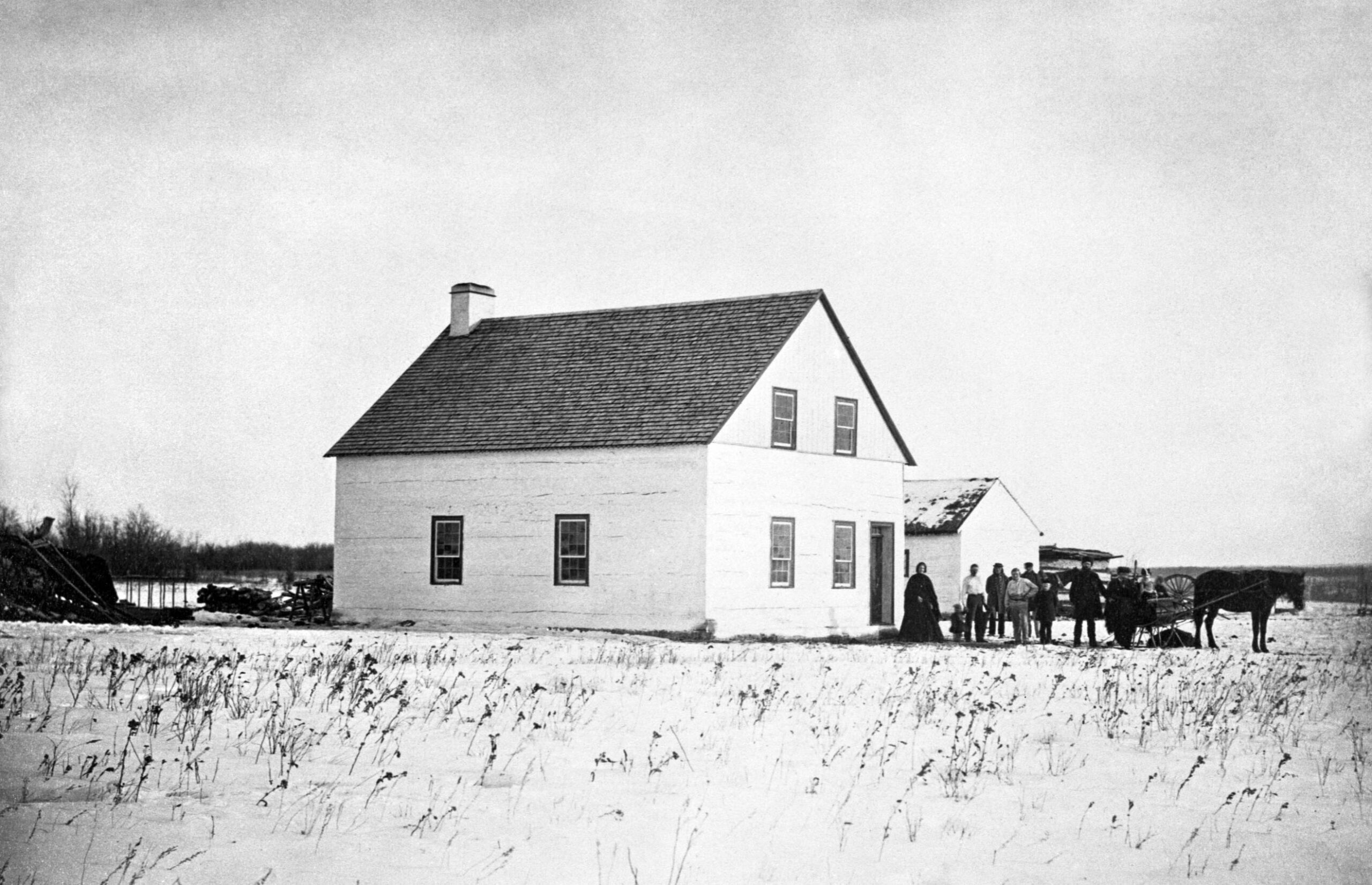The year 2021 will be the 150th anniversary of the construction of Reverend George McDougall’s 1871 Methodist Mission House. This important building serves as an opening chapter for a number of significant stories of young Edmonton. Like all of the earliest frontier homesteads that dotted the Edmonton skyline in the 1870s, the Mission building would come to have a versatile and dynamically evolving use over time. Before its presence came to an end, it would pass through the hands of Edmonton’s first mayor and others en route to becoming a Jasper Avenue bastion of commerce: notably, one of foundational significance to all of the key players in the town’s early Jewish business community. Although such an evolution might have seemed decidedly incongruous from the perspective of McDougall’s Christian zeal (if he had lived to witness it), it was nonetheless a fitting example of the diverse plurality of purpose which characterized the early community architecture of a rapidly growing boomtown.
Reverend McDougall arrived with his family from Victoria Settlement on May 16, 1871.[1] He had previously selected the site for his intended Edmonton mission to be a spot looking out from the high bluff which he dubbed “Wesley Hill.”[2] Construction began immediately, and the Mission House was completed and occupied by mid-November the same year.[3]
The parsonage was erected by future lumberman John Walter together with Fort Edmonton’s long-serving Métis carpenter Eustace Berard, both “on loan” from the Fort. Other helping hands included fort sawyers Lawrence Fullerton, the gold miner Gilbert Anderson, and “Washee Joe,”[4] one of the early denizens of the Ross Flat. Construction was partially funded by a cash donation from Fort Edmonton’s Chief Factor Richard Hardisty, a son-in-law of Reverend McDougall.
Pictured left: Methodist Missionary Reverend George McDougall, circa 1860s. Image courtesy of Glenbow Collection, Archives and Special Collections, University of Calgary [PC-242-1].
By Reverend McDougall’s own estimate, the cost of building the Mission House was over twelve hundred dollars, excluding labour.[5] The Mission was 23 by 33 feet, two stories high and finished with dressed, local spruce lumber sawed by hand. It consisted of five rooms including a large kitchen and was regarded by Reverend McDougall as “one of the best finished buildings in the country.”[6]
The establishment of this Mission represented a major pivot point in the evolution of early community, and the house has frequently been acclaimed as the first building erected outside the walls of Fort Edmonton. While this is far from being true, its construction nevertheless represents a very important accelerant in the story of the historical entity that would come to be known as “Edmonton Settlement.”
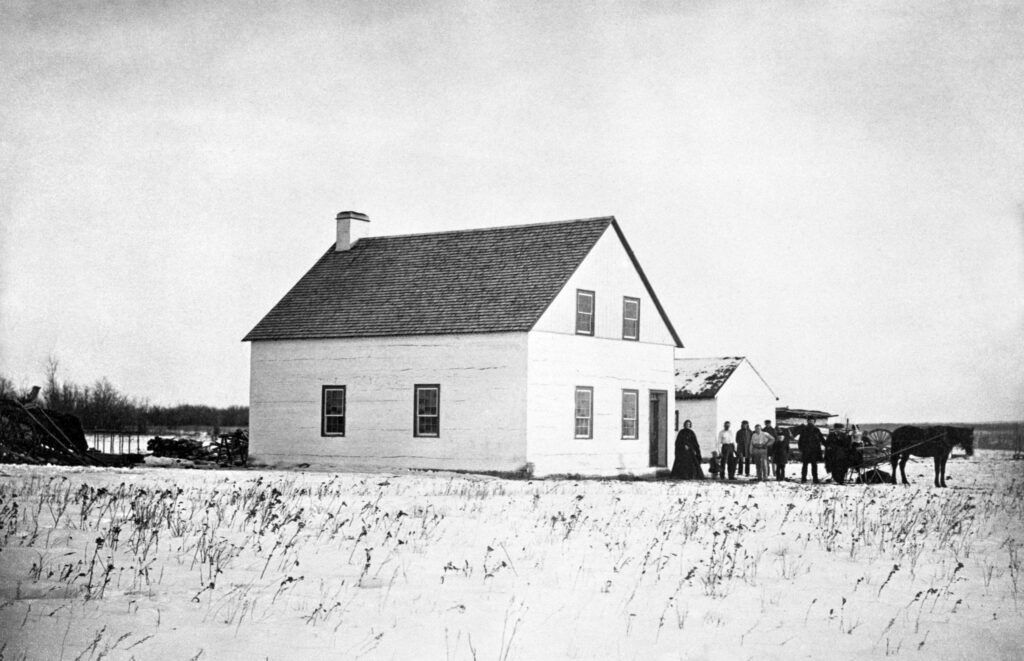
McDougall Mission House, November 1871. Photographer Charles Horetzky, earliest photograph in existence of Edmonton’s upper downtown core. Modern day MacDonald Drive. Photo provided by the author, courtesy of the Glenbow Archives, Archives and Special Collections, University of Calgary [NA-1408-6]. 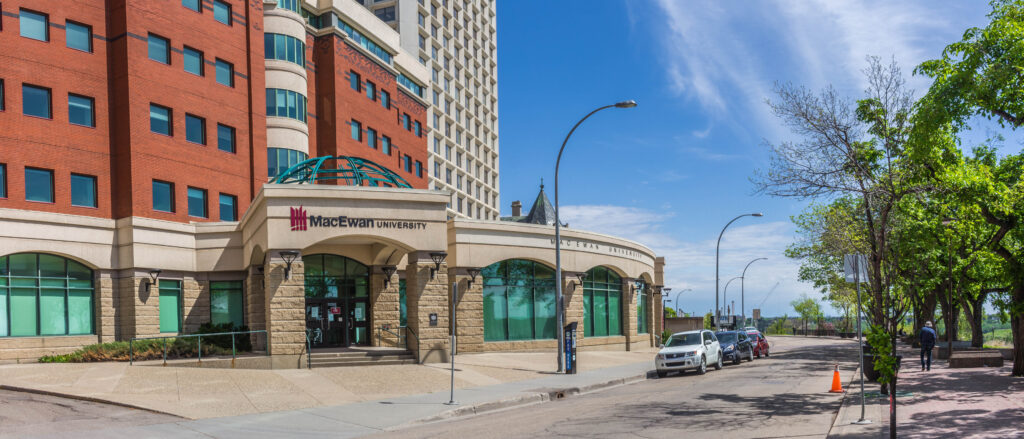
Present day site of the original Mission House. Photographed by the author, 2019.
An 1871 photograph taken only weeks after the building’s completion is the earliest photograph in existence of Edmonton’s future downtown core.[7] It features Reverend McDougall and his family, and likely includes his Hardisty grandchildren. An equivalent 21st-century view from the vantage point of the camera would correspond with the front entrance to MacEwan / Alberta College Library on Macdonald Drive.
Following Reverend McDougall’s death in a blizzard in 1876, the house was subsequently occupied by Reverend Arthur Whiteside. Whiteside left behind a handful of cartoonish sketches of 1880s Edmonton, including ones of the mission building, the 1871 stable and the first McDougall church which was to follow two years later. Following Whiteside’s occupancy, Edmonton’s future Mayor McCauley lived in the building for some time as custodian and principal defender against “claim jumpers” in the early 1880s. McCauley personally laid a new foundation under the building in 1889.
The Mission was a hub of activity throughout the 1880s, used variously for “singing lessons every Friday evening,” as a Social for the Ladies’ Aid Society, and for garden parties featuring the Fire Brigade Band. For several months in 1892, Dr. Goodwin the dentist conducted his services from the house.
Reverend Author Whiteside’s sketch of the Mission House, 1880. Image courtesy of the Glenbow Collection, Archives and Special Collections, University of Calgary [NA-1233-5]. The Edmonton Fire Brigade Band performed concerts in the Mission House in the 1890s. Seated at centre is Henry Sigler, who later conducted business out of the Mission House. Photo courtesy of the Provincial Archives of Alberta, B8705.
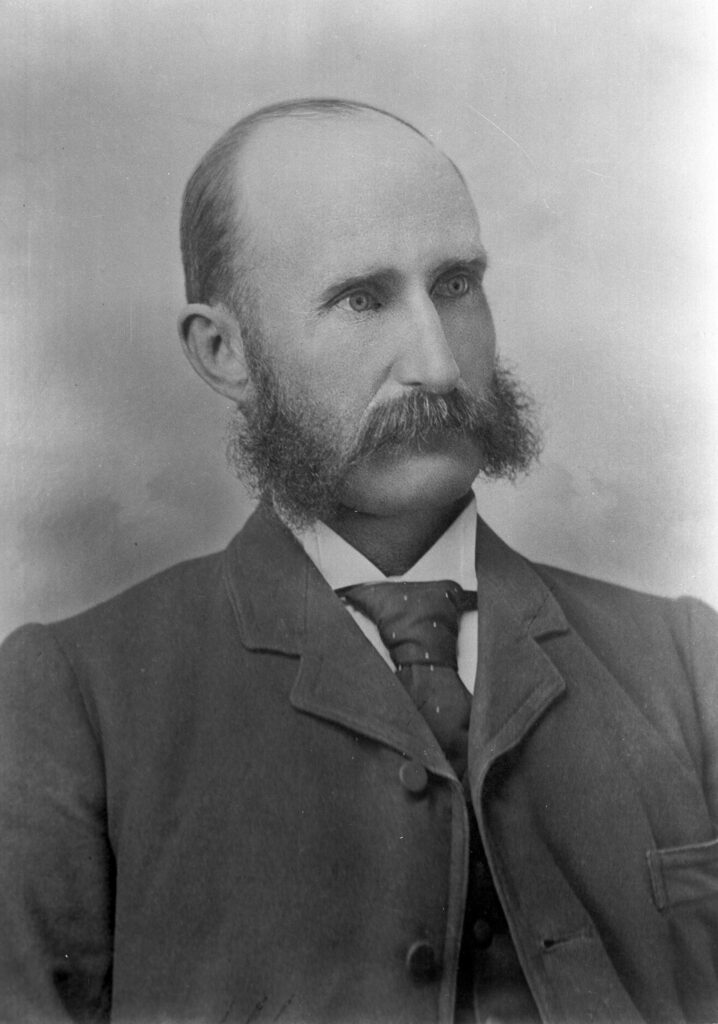
By 1895, the building was standing in the way of construction for the new Edmonton High School. Tenders were posted to have it purchased and removed, and in July it was acquired by previous occupant Matthew McCauley — by this time serving his third year as Edmonton’s first mayor.[8] McCauley dragged the building east onto his own property fronting on 100th Street, directly opposite the future Macdonald Hotel. He was living on a block of property adjoining and previously purchased from the Methodist claim, on which he operated his livery stable for many years until it burned down in 1902, along with eighteen of Edmonton’s best horses.
Pictured left: Edmonton’s first mayor, Matthew McCauley, lived in the Mission House as custodian for a number of years, and later bought the Mission and dragged it to his own property. Photo courtesy of the City of Edmonton Archives, EA-10-1565.
The presence of the former Mission House on McCauley’s property was short lived. A few months later he leased the building to the auctioneering firm of Turnbull and McAdam, and it was dragged once more to a final destination on Jasper Avenue for use as an “auction mart.”[9] It was likely J. R. Turnbull who “modernized” the building at this point by adding a boomtown facade in the style consistent with many of Edmonton’s other frontier town businesses. For the rest of the Mission building’s life, it would be rebranded as “235 Jasper Ave. East.”
It is unclear how long Matt McCauley retained ownership of the building, and it is undetermined whether or not there was a succession of ownership prior to its acquisition by a Seattle investor circa 1908. It is clear, however, that by early 1896, lease and occupancy of the building was transferred to the partnership of Abraham Cristall and Henry Sigler,[10] notable as the first (1893) and second (1895) pioneers of Edmonton’s early Jewish business community. From that point on and for the rest of the building’s life, it would serve as a cornerstone of the Jewish mercantile fraternity as it evolved through a succession of enterprises. “Sigler &Cristall” operated a General Goods store for a number of years, during which they made additional modifications including the removal of all internal partitions.
Following his marriage in 1899, Sigler bought out Cristall’s share of the partnership to become sole proprietor.[11] A photograph of Jasper Avenue taken between 1899 and 1902 reveals the side of the building painted with his fading signage that read, “H. Sigler, General Merchant.”
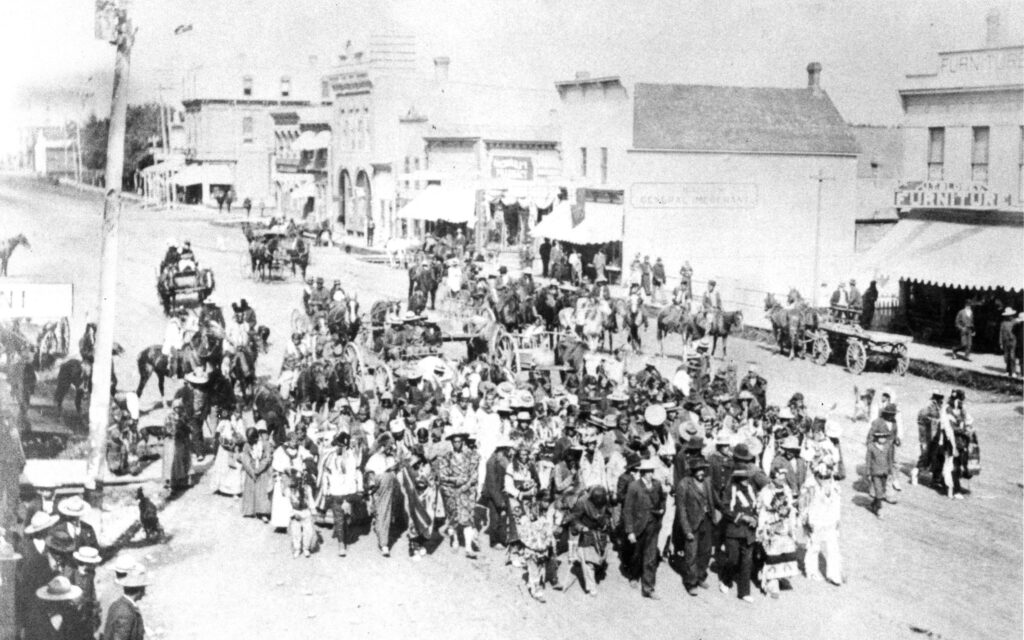
After 1902, Sigler turned his attention to the hotel business with construction of the Grand View on 100thStreet — predecessor to the Macdonald Hotel. At this point, the lease of McDougall’s mission house was turned over to William “Boss” Diamond, another Jewish entrepreneur, who operated The Diamond Clothing Company for the next four years.[12] Charles Benjamin, one of Diamond’s store managers, was an artist and probable creator of the diverse illustrations that accompanied the clothier’s advertisements. In 1906, the building was again refashioned with “complete renovation” into the “Edmonton Clothing Company” of Calgary tycoon William Sugarman, and, later, “William Sugarman Clothing” — continuing an unbroken succession of businesses by Jewish entrepreneurs that would span the course of a decade and a half, to the end of the trail.[13]
For nearly a third of its life the Methodist Mission house served a consequential role as epicentre of prototype clothier establishments conducted by those who would quickly emerge as prominent Edmonton businessmen and community builders, over and above their roles as principle builders of Edmonton’s pioneer Jewish community.[14]

Henry Sigler drew on the commercial success of his clothing store to become a successful hotelier, gaining a reputation which prompted the evaluation that “there is perhaps no more popular or widely known hotel man in the province.”[15] Following Sigler’s years in Edmonton he moved to Vancouver to build its first synagogue, a theatre, and other businesses. William Sugarman left his mark on Edmonton with the business block bearing his own name: the Sugarman Block was home to the Monarch, “Canada’s Most Beautiful Motion Picture Theatre.”[16]
All men played key roles in the creation of the Edmonton Hebrew Association in 1906. Abraham Cristall donated land for Edmonton’s first synagogue,[17] William Diamond was first president of the Association and personally laid the corner stone at a dedication in August 1911. Sharing the stage with Cristall and Diamond were Lt. Governor Bulyea, ex-mayors Robert Lee and William Short, and Minister of the Interior Frank Oliver, who singled out Abraham Cristall and Henry Sigler who “he had known for many years and who were pioneers of the province helping much in the progress and advancement of the community.”
The synagogue, like the mission house before it, faced an eventual repurposing and survives today as a German Catholic church, disguised by a protective cover of siding — perhaps lying in wait for some future day of restoration.
The little 1871 Mission faced its final stand on Jasper Avenue in 1911 when the property was purchased by the gentile firm of Jackson Brothers Jewellers, successors to the 1886 firm of Raymer, Edmonton’s pioneer jeweller. The Mission was swiftly replaced with a modern, four storey office block designed by architect Edmund Wright.
As one building rises in Edmonton, another falls. Demolition of the old McDougall Mission in July 1911 was exactly 40 years — to the month — from when the sawyers of Fort Edmonton first began squaring logs to build it. Like all of Edmonton’s earliest frontier buildings, the 1871 parsonage had served its time well.
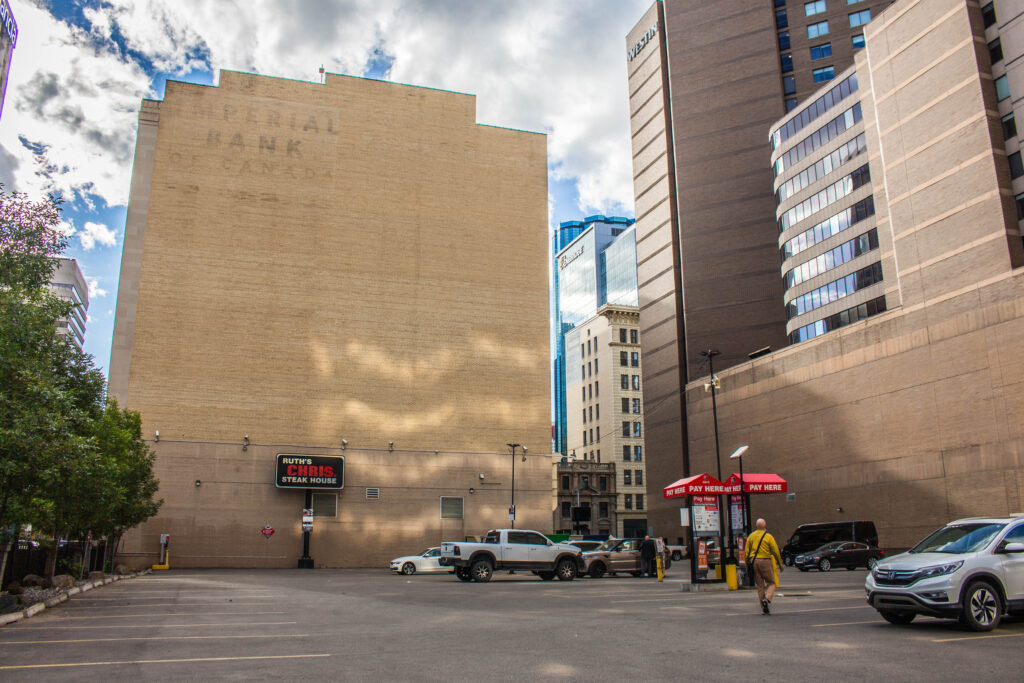
Dylan Reade © 2020
[1] Fort Edmonton Post Journals, May 16, 1871: “Rev. George McDougall & Family arrived from Victoria, come up here to commence a Mission.” Hudson’s Bay Company Archives B/60/a/38, microfilm 1M1003. The date is corroborated by church secretary William Leslie Wood in a letter “To the Editor of the Edmonton Bulletin” published July 1, 1882.
[2] After John Wesley, founder of Wesleyan Methodism.
[3] Fort Edmonton Post Journals indicate that McDougall returned with his family from Victoria on November 16th the same year. Occasional tidbits of the building’s construction and associated workers are peppered throughout the Journal from June to November.
[4] Wasejo, a.k.a. Michel Vivier, a veteran day labourer with the Hudson’s Bay Company, was consistently employed at Fort Edmonton from the late 1850s. As one of the original inhabitants of the future Ross Flat, his quit claim on the property was among several that gold miner Donald Ross negotiated in the early 1870s in order to assert his own claim on the River Lot.
[5] Letter, Reverend George McDougall, October 23, 1871. Published in “The Wesleyan Missionary Notices,” Fourth Series, Volume IV. London: The Wesleyan Mission House, 1872, page 77. The Edmonton Bulletin (July 11, 1895) states the building cost as $1600; the price is alternately stated at over three thousand dollars by Dr. Lachlan Taylor, a visiting Missionary, in Leaves From My Life in the Prairie Province, 1868-1874, page 265. Toronto: William Briggs, 1897.
[6] Ibid, Letter, Reverend George McDougall.
[7] Photographed by Charles Horetzky on an advance scout for Sandford Fleming’s CPR survey which was to occur the following year.
[8] Edmonton Bulletin, July 11, 1895, page 1: “The old Methodist parsonage is being removed to M. McCauley’s property, he having purchased it.”
[9] Edmonton Bulletin, Dec. 1, 1895, page 1: “Turnbull & McAdam have leased from M. McCauley the building which was formerly the Methodist parsonage and will move it out to Jasper Avenue for use as an auction mart.”
[10] Edmonton Bulletin June 29, 1896, page 1: “ “Sigler & Chrystal [sic] have removed their stock into the store lately occupied by W. McAdam & Co. where they commenced doing business in earnest this morning.” They advertised their new business in “Turnbull & McAdam’s old stand next to [D. W.] McDonald’s new drug store.”
[11] Sigler and Cristall appear to have remained close in the following years. They posed together in a studio portrait taken over six years later.
[12] Edmonton Bulletin, Feb. 3, 1902: “W. Diamond, of Calgary, will open up on March 1st, in H. Sigler’s old stand with a stock of gent’s furnishings. Mr. Benjamin will be in charge.”
[13] William Diamond expanded his business into the new Dyke Block, only a few doors to the west.
[14] An 1899 town census reveals that out of Edmonton’s population of 2212, only twelve were adherents of the Jewish faith. Henry Sigler along with the Cristall family filled over a third of the demographic.
[15] Edmonton Bulletin, June 23, 1908.
[16] 10075 Jasper Avenue. Built 1911.
[17] 95th Street and Grierson, today reconstituted as St. Boniface German Catholic church.

